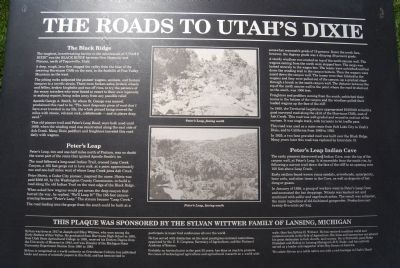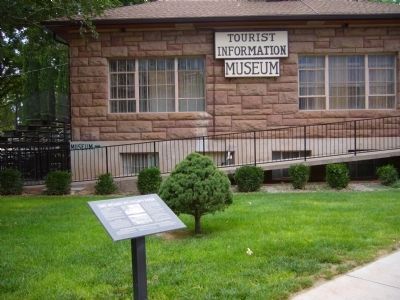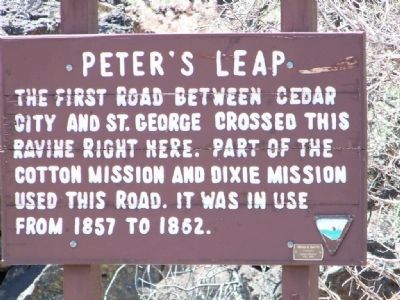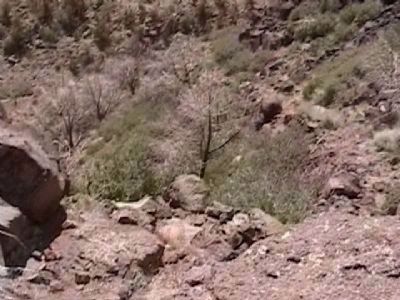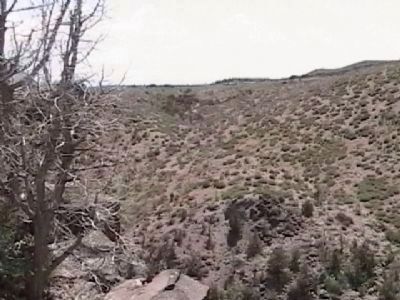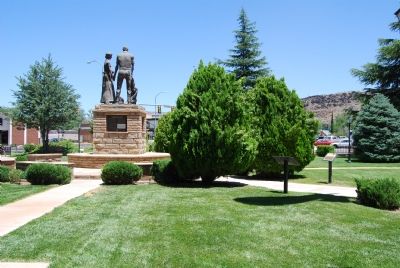Hurricane in Washington County, Utah — The American Mountains (Southwest)
The Roads to Utah’s Dixie
A deep, rough, lava flow clogged the valley from the base of the towering Hurricane cliffs on the east, to the foothills of Pine Valley Mountain on the west.
The jolting rocks subjected the pioneer wagons, animals, and human tempers to a terrific strain. There were broken axles, broken wheels and fellies, broken kingbolts and run-off rims, to try the patience of the weary travelers who were forced to resort to their own ingenuity in making repairs, being miles away from any possible relief.
Apostle George A. Smith, for whom St. George was named, proclaimed this road to be “The most desperate piece of road that I have ever traveled in my life, the whole ground being covered for miles with stones, volcanic rock, cobbleheads—and in places deep sand.”
This old pioneer trail and Peter’s Leap Road, were both used until 1869, when the winding road was constructed along the east side of Ash Creek. Many Dixie peddlers and freighters traveled this road daily with wagons.
Peter’s Leap. Peter’s Leap, two and and one-half miles north of Pintura, was no doubt the worst part of the route that ignited Apostle Smith’s ire.
The road followed a long-used Indian Trail, crossed Leap Creek Canyon, a 165 foot gorge cut in lava rock, at a point approximately one and one-half miles west of where Leap Creek joins Ash Creek.
Peter Shirts, a Cedar City pioneer, inspired the name. Shirts was paid $300.00 by the Washington County Commission, to build a road along the old Indian Trail on the west edge of the Black Ridge.
When asked how wagons would get across the deep canyon that barred the way, he replied, “We’ll Leap It!” The 165-foot canyon-crossing became “Peter’s Leap.” The stream became “Leap Creek.”
The road leading into the gorge from the south could be built at a somewhat reasonable grade of 15 percent. Down the north face, however, the dugway grade was a dizzying 30 percent grade.
A sturdy windlass was erected on top of the north canyon wall. The wagons coming from the north were stopped here. The cargo was lashed securely to the wagon box. The teams were unhitched and led down the winding trail to the canyon bottom. Then the wagons were eased down the canyon wall. The teams were then hitched to the wagons and they were pulled out of the canyon, up a gradual slope through a break in the south canyon wall. The distance between the top of the north canyon wall to the point where the road leveled out on the south, was 100 feet.
Freighters and peddlers coming from the south, unhitched their teams in the bottom of the canyon and the windlass pulled their loaded wagons up the face of the cliff.
In 1869, the Territorial Legislature appropriated $1000.00 to build a good surveyed road along the skirt of the Hurricane Cliffs, east of Ash Creek. This road was well-graded and wound in and out of the ravines. It was a single track, with turnouts to let traffic pass.
This road was used as a main route from Salt Lake City to Utah’s Dixie, and to California from 1869 to 1925.
In 1925, a two-lane graveled road was built over the Black Ridge. Many years later this road was replaced by Interstate 15.
Peter’s Leap Indian Cave. The early pioneers discovered an Indian Cave, near the top of the canyon wall, at Peter’s Leap. It is accessible from the south rim, by following a narrow trail down the face of the cliff to an opening over 100 feet above Leap Creek.
Early settlers found woven yucca sandals, arrowheads, spearpoints, bone awls and other items in the Cave, as well as deposits of bat dung or guano.
In January of 1858, a group of workers went to Peter’s Leap Cave and excavated the bat droppings. Nitrate was leached out and combined with sulfer and sagebrush ashes. The result was saltpeter, the main ingredient of old-fashioned gunpowder. Production cost: twenty-five cents per keg.
This Plaque was Sponsored by the Sylvan Wittwer Family of Lansing, Michigan. Sylvan was born in 1917 to Joseph and Ellen Wittwer, who were among the Early Settlers of this Valley. He graduated from Hurricane High School in 1935, from Utah State Agricultural College in 1939, received his Doctors Degree from the University of Missouri in 1943, and was Director of the Michigan State University Experiment Station from 1965 to 1983.
Sylvan is recognized as a world authority on Greenhouse Culture; has published books and scores of scientific papers in this field; and has been invited to participate in major food conferences all over the world.
He has served with distinction on the most prestigious national committees, appointed by the U.S. Congress, Secretary of Agriculture, and the National Academy of Science.
Probably no horticulturist in the past 50 years, has done as much to promote the cause of technological agriculture and agricultural reasearch on a world-wide scale, than has Sylvan H. Wittwer. He has received countless world and national awards in the field of Agriculture. His fame and success has not altered his great dedication to God, church, and country. He is Patriarch, past Stake President and Bishop
in Lansing Michigan L.D.S. Stake, and has actively served as a leader and supporter of the Boy Scouts of America.
We salute Sylvan as a noble native son with a rich heritage in Utah’s Dixie!
Topics. This historical marker is listed in this topic list: Roads & Vehicles. A significant historical month for this entry is January 1858.
Location. 37° 10.568′ N, 113° 17.32′ W. Marker is in Hurricane, Utah, in Washington County. Marker is on State Street. It is in Hurricane Valley Heritage Park. Touch for map. Marker is at or near this postal address: 35 W State Street, Hurricane UT 84737, United States of America. Touch for directions.
Other nearby markers. At least 5 other markers are within walking distance of this marker. Hurricane City (here, next to this marker); Survival in Utah’s Dixie (a few steps from this marker); Hurricane Canal (a few steps from this marker); Smith Mesa (a few steps from this marker); Hurricane Pioneers (a few steps from this marker). Touch for a list and map of all markers in Hurricane.
Credits. This page was last revised on June 16, 2016. It was originally submitted on June 28, 2007, by Dawn Bowen of Fredericksburg, Virginia. This page has been viewed 2,525 times since then and 58 times this year. Photos: 1. submitted on June 28, 2007, by Dawn Bowen of Fredericksburg, Virginia. 2. submitted on September 10, 2012, by Bill Kirchner of Tucson, Arizona. 3. submitted on June 7, 2009, by Clair Edmunds of Mt. Pleasant, Utah. 4, 5. submitted on June 12, 2009, by Clair Edmunds of Mt. Pleasant, Utah. 6. submitted on June 28, 2007, by Dawn Bowen of Fredericksburg, Virginia. • J. J. Prats was the editor who published this page.
